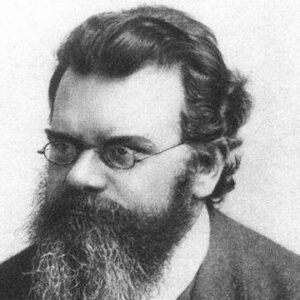Ludwig Eduard Boltzmann was an Austrian physicist noted for his statistical mechanics research. Ludwig, who came from a middle-class household and lost his father while he was young, was aided in his scientific endeavors by his mother. He received private tutoring at home at first, and afterwards attended high school in Linz. Ludwig studied physics at the University of Vienna, where he was influenced by such luminaries as Josef Stefan and Andreas von Ettingshausen. He obtained his PhD and became a lecturer under Stefan’s tutelage. Ludwig studied under Bunsen and Helmholtz and taught in Graz, Heidelberg, and Berlin. He met his wife, Henriette, while he was in Graz. Boltzmann was noted for his erratic mood swings, which had a considerable impact on his career path. His statistical mechanics work was mostly based on probability theory and was strongly linked to the Second Law of Thermodynamics. Some of his beliefs were considerably ahead of their time, which drew vehement resistance from his peers. During his visits to the United States, he gave lectures on applied mathematics, but he had no idea that fresh radiation discoveries would help him prove his beliefs. His despair and deteriorating mental state eventually prompted him to commit suicide while on vacation with his family.
Childhood and Adolescence
Ludwig Boltzmann was born on February 20th, 1844, to a tax official father and a Salzburg-born mother, Katharina Pauernfeind. His grandfather was a clockmaker who had relocated to Vienna from Berlin.
The family relocated to Wels, Upper Austria, when Boltzmann was born, and later to Linz, where Ludwig attended secondary school. He was initially home-taught, and the young lad was fascinated by plants and collected butterflies from an early age.
Ludwig studied at the ‘University of Vienna,’ graduating with a PhD in 1866. Josef Stefan was his supervisor and his thesis topic was kinetic theory of gases.
Career of Ludwig Boltzmann
Ludwig became Stefan’s assistant, and in 1866, he obtained multiple roles as physics and mathematics professors in Graz, Munich, and Leipzig. The next year, he delivered his first lecture as a lecturer.
Boltzmann became a professor of theoretical physics in Graz in 1869, a position he retained for the next four years.
He also spent a lot of time in Heidelberg with Robert Bunsen and Königsberger in the same year.
In Berlin in 1871, he collaborated closely with Gustav Kirchhoff and Helmholtz. He obtained a position at Vienna for Mathematics two years later. His stay was cut short, however, due to his numerous moves, and he returned to Graz, this time to the department of experimental physics.
Boltzmann authored numerous papers in the 1870s explaining how the second law of thermodynamics can be better explained by applying the laws of mechanics. He also mentioned that the probability theory can be used to atom movement.
In 1881, he cooperated with Maxwell to develop the Maxwell-Boltzmann law idea. The following year, this learned physicist was named director of the Theoretical Physics department at the University of Munich in Bavaria.
Ludwig took over his professor Stefan’s job in the department of theoretical physics after his mentor’s death in 1894.
This position, though wanted by Ludwig, was lost when Ernst Mach, Ludwig’s scientific adversary, was selected as the head of Vienna’s history, philosophy, and sciences.
Ludwig relocated to Leipzig in 1900 after a falling out with Mach, where he worked alongside another of his most vehement opponents, Wilhelm Ostwald. Despite the fact that they were on excellent terms personally, Ludwig’s scientific differences drove him to contemplate suicide.
After Mach retired in 1901, Ludwig returned to Vienna the next year and resumed his theoretical physics chair, which had been vacant since he left Vienna. He was nominated by Emperor Francis Joseph on the condition that he never accept a job outside the Empire.
Ludwig was offered the philosophy course taught by Mach during his second spell in Vienna, which he gladly accepted. His talks were so popular that even the largest auditorium in the building couldn’t hold all of his attendees.
Major Projects of Ludwig Boltzmann
Boltzmann used statistical mechanics to describe the second rule of thermodynamics. He continued his research and attempted to develop a general law for energy distribution in various regions of the system. The experiment was carried out at a certain temperature, which led to the Maxwell-Boltzmann law.
This distinguished scientist was one of the few persons of his time to recognize the promise of James Clerk Maxwell’s electromagnetic theory.
Achievements & Awards
Boltzmann was elected to the Imperial Austrian Academy of Sciences in 1885.
He was elected President of the University of Graz in 1887.
Ludwig became a member of the Royal Swedish Academy of Sciences in 1888.
Ludwig was elected a Foreign Member of the Royal Society in 1889.
Oxford awarded him an honorary doctorate.
Personal History and Legacy
In 1872, when women were not permitted to attend Austrian institutions, Henriette von Aigentler, a young and energetic mathematics and physics teacher, was denied permission to observe lectures illegally. Boltzmann asked her to file an appeal against the dictate, which she did.
Ludwig married Henriette in 1876, and the couple had three daughters and two boys.
Boltzmann committed suicide while on vacation with his family in 1906, after suffering from a depressive episode.
Because he made significant contributions to the creation of statistical mechanics, an essential part of theoretical physics, the Boltzmann constant was named after him.
Estimated Net Worth
Ludwig is one of the wealthiest physicists and one of the most well-known. Ludwig Boltzmann’s net worth is estimated to be $1.5 million, according to Wikipedia, Forbes, and Business Insider.
Trivia
Boltzmann had significant mood swings and episodes of sadness, and he was diagnosed with bipolar disorder on several occasions.


